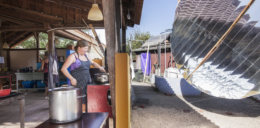Technology Month Report: June 2018
The sun is our partner in the shift from fossil fuels to a brighter future.
Tamera’s Solar Test Field exists to test, develop, showcase and adopt decentralized solar technologies in a living social environment. For the month of June 2018, the team here was working particularly intensely together with a group of visiting specialists from around the world to advance several solar projects and at the same time enjoy testing social structures that support cooperation among humans.
Douglas Baillie, August 3, 2018

We made excellent progress:
One major focus was solar cooking. Are we aware that 4 million people still die each year from indoor cooking smoke, from cooking over open fires? That people who cook on wood or charcoal often spend a major portion of their life gathering firewood, causing deforestation and thereby soil erosion, floods and ecological disaster? That the promoted alternative, so-called “natural gas” used in our so-called clean kitchens is even more destructive? We need to remodel our picture of cooking. What can help? The indigenous and exploited people of the Global South say to us: Change the dream of your own culture! Solar cooking is a vital possibility for changing the situation.
We particularly focused on solar cooking for 1 week of our time together. We spent time building and using several solar cooker designs, testing them in real-life conditions in our solar kitchen, listening to feedback from users, modifying designs, finding appropriate recipes and finally making decisions on which designs are appropriate for local conditions. The cookers included 2 modified Jaholnitsky parabolas, a Tolokatsin box, several other box cookers, 3 Pucca concrete funnel cookers and various lightweight portable funnels, a rebuilt SK14 and our trusty Scheffler mirror.
According to our engineers, the most valuable part of the month was the exchange with users. It is important to be aware that the same communication and interaction issues that come up here also play out on a global level when we ask why knowledge transfer so often fails. It was meaningful to look at the details of our situation and know that these situations determine the success or failure of global help. Forum work provided the possibility to communicate on a deep level to see the underlying issues and understand why feedback is heard or ignored.
Our low-temperature SunPulse Water Stirling engine was completely stripped down and refurbished. This stand-alone solar pump was one of the early developments from the laboratory of Juergen Kleinwaechter and his team. And it’s still one of our favorites. Several ideas came up for modifications/upgrades and we are happy to get the engine in our focus again.
One team upgraded our existing analog solar tracker to a versatile Arduino-based system. We want to make this design open-source. Our Technology team is increasingly embracing open-source practices and we intend to take the time this fall to develop a professional strategy and online structure for this.
One team focused on the question of whether Tamera could/should undertake a development project around solar lime-burning. Lime could be a key alternative to Portland cement in giving the building sector a new profile. Are we aware that CO2 emissions from Portland cement production are more than the CO2 emission of worldwide flights?
Every material we use also has a spiritual aspect. With lime, we had the feeling that we could get closer in dreams. In the past, lime-burners would say that they burn the bones of the Earth. What spiritual space will open once we discover that even materials are not dead but part of our living universe?
We updated our membrane mirror with new membranes and a new clamp design.
Felix Heddiger exhibited many examples of his impressive technical and artistic work on resonance, pulsation and inversion technologies, experiments towards technological developments in cooperation with life energies. He also built 2 small-scale demonstrators of solar thermoacoustic Stirling engines, in which energy is transferred via heating/cooling induced acoustic waves.
Dave Hakkens, the successful open-source mind behind the highly inspirational Precious Plastic, worked with us, particularly advising how to make a shift to open-source technology: a concept that has been dear to us for a long time, and which we are now starting to embrace in practice.
Daniel Mueller designed a next-generation high temperature receiver for our membrane mirror, intended for experiments in metalwork, lime burning and other high temperature processes at around 1000 degrees Celsius.
This was an excellent way to get work done, to get to know interesting people with whom we can work in the future, and to explore ways in which our work has a meaningful impact.
THANK YOU!

